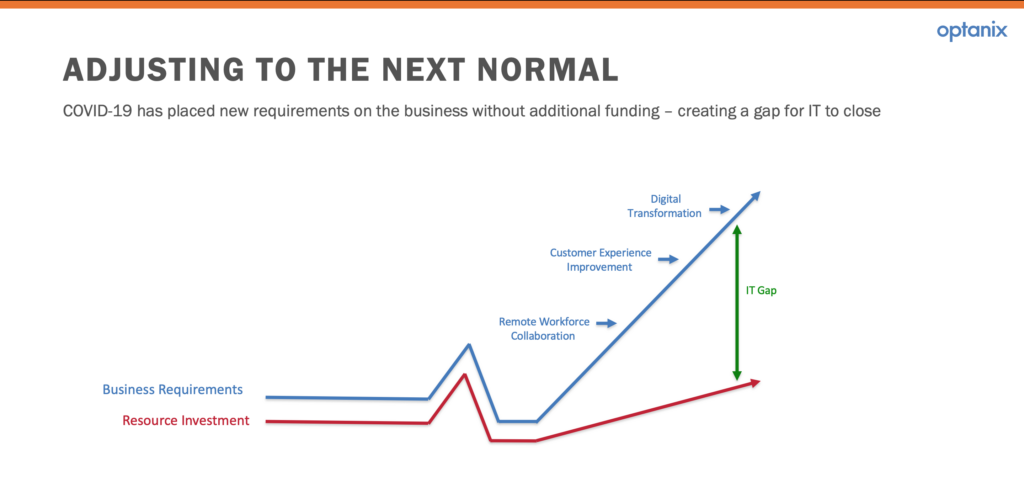
The CIO and COVID: How to Enable Growth and Increase Resilience
Part 2 of 2: Long-Term Actions & Recommendations
In a recent post, we explored the short-term implications for the CIO as they deal with the COVID-19 crisis. Their focus for the immediate future should be on adapting to the new normal: reopening business and reigniting revenue streams.
In this post, we’ll break down the long-term strategy that the CIO should follow, as proposed by Gartner in their March 2020 report “Coronavirus (COVID-19) Outbreak: Short- and Long-Term Actions for CIOs.” The CIO’s long-term approach needs to shift from addressing the new normal toward addressing the next normal: increasing resilience to future crises and driving growth while sustaining IT ops.
COVID Challenges & Recommendations for the CIO
Remote Working is Here to Stay
- Challenge: COVID has forced IT organizations to maintain business continuity while trying to adapt to a largely remote workforce. This has resulted in an increased dependency on collaboration tools to support remote working capabilities. In the long term, as this trend goes mainstream, organizations face continuing challenges in adapting to the digital workplace.
- Recommendation: In order to empower employees and improve efficiency, CIOs need to develop a robust digital workplace strategy. The lessons learned in the short term provide a stepping stone to building out that strategy. The goal is to have the technologies, tools and processes in place to normalize work-from-home as a formal way to operate. It should also explore alternative employment modes such as freelancers who can be sourced and managed virtually.
Dramatic Swings in Market Forces
- Challenge: Customer demand and revenue generation have been impacted by COVID-19 in different ways based on the kind of activity in which a business engages. There is wide variation, with some businesses facing a complete loss of revenue while others can barely keep up with demand. In the long term, the challenge is to build resiliency to fluctuations in the market.
- Recommendation: Organizations need to reevaluate product offerings, business models and go-to-market plans to reflect the changing needs of the marketplace. In order to do this, they need to build capabilities that provide the agility to switch rapidly between physical and digital channels. This is essential to redirect operations to working channels or product offerings when others are proving to be less profitable. In addition to the resiliency this provides, it sets up the business to capitalize on new opportunities as they arise.
Rising Anxiety Levels
- Challenge: As the uncertainty continues, confusing and conflicting information about COVID-19 is rampant. This leads to widespread anxiety amongst remote workers and customers. In addition, it makes business decision making error-prone, which results in additional barriers to resuming operations. The challenge in the long-term is to put in place systems that maintain cohesive communication and enable better decision making.
- Recommendations: The goal here is to ultimately improve data literacy. CIOs need to build a business culture that communicates, understands and puts data to use in order to reduce misinformation and to enable decision making. They need to encourage employees to participate in data-for-good programs that transcend organizational boundaries. Embracing data literacy also provides for increased dexterity in running a digital business – which will provide further tangible benefits in the long run.
The Takeaway
The long-term actions and recommendations described here serve to impact the CIO’s organization in two fundamental ways:
- They prepare the overall business to deal with crisis and change by building in resilience against future disruptions.
- They provide increased agility in the ability to respond to new opportunities by developing a business model that can rapidly pivot to support future growth.
The COVID crisis has also exposed organizations to a new challenge. As business requirements have increased, resource investment has not been able to keep up. The net result is a mismatch in funding best described as an “IT gap” (as shown in the figure below). To rise to the challenge, more than ever before, CIOs need to maximize the effectiveness of their tools, processes and people.

To learn how Optanix can help close the IT gap please contact us.